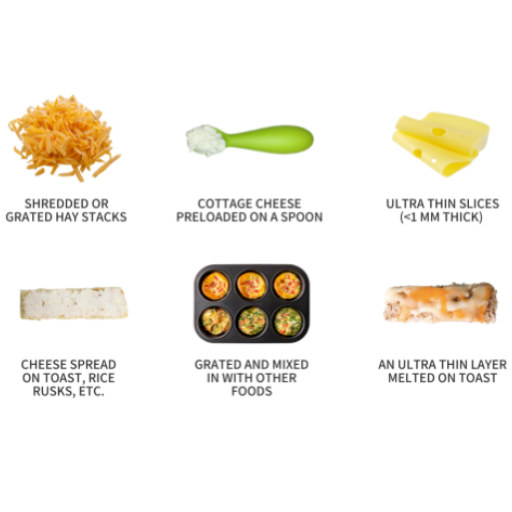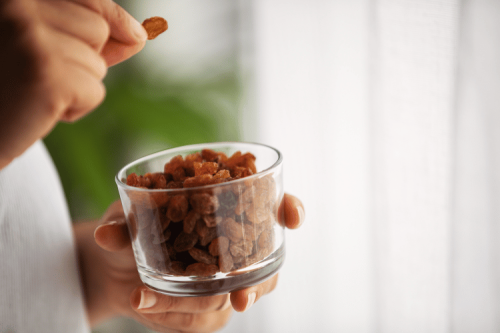
What Makes String Cheese a Potential Choking Hazard?
 String cheese can cause choking due to its achieved shape and texture. It is a cylindrical object, which, when stringy or rubbery, can become stuck in a toddler’s airways if the toddler swallows it in large, unmanageable pieces. When cool, the string cheese’s consistency tends to be firm, making it hard for a toddler who has not yet developed chewing skills to break it down properly. This risk is heightened because toddlers are known to take large bites or may not chew properly, thus making pieces of food lodged in the throat on the first try. To mitigate the risk, caregivers should always ensure that the cheese is cut into small, more manageable pieces and that children are constantly monitored.
String cheese can cause choking due to its achieved shape and texture. It is a cylindrical object, which, when stringy or rubbery, can become stuck in a toddler’s airways if the toddler swallows it in large, unmanageable pieces. When cool, the string cheese’s consistency tends to be firm, making it hard for a toddler who has not yet developed chewing skills to break it down properly. This risk is heightened because toddlers are known to take large bites or may not chew properly, thus making pieces of food lodged in the throat on the first try. To mitigate the risk, caregivers should always ensure that the cheese is cut into small, more manageable pieces and that children are constantly monitored.
Why is String Cheese a Concern for Young Children?
String cheese is a concern for infants as it poses a risk of choking. It is, of course, a better option than hotdogs and sausages, but if young children are still at the stage where they do not have teeth, the danger still looms. Authoritative Figures state that Kids often take huge bites out of their meals or even swallow big chunks of food. Due to this reason, kids usually end up eating too big a chunk of cheese or cheese that is hard and slithery, which gets caught in their throat, making it difficult to speak or breathe. Thankfully, someone has suggested that they mesh string cheese or even cut it into tinier parts, altering its shape. Furthermore, if adults watch kids and their eating habits as a last resort, it would significantly help decrease the chances of chunks of cold string cheese getting stuck in kids’ throats.How Does the Texture of String Cheese Contribute to Choking Risks?
What Are the Common Choking Hazards Associated with Cheese?
Cheese poses several choking hazards, particularly for young children. The primary concern is its texture and size when not prepared appropriately. Here are some common hazards:
- Texture: Cheeses with a firm and rubbery texture, such as string cheese, can be challenging to chew and quickly become lodged in a child's throat if not sufficiently broken down.
- Size: Large chunks or slices of cheese are a risk, as they can obstruct the airway if a child attempts to swallow them whole.
- Stickiness: Some cheeses become sticky when chewed, which can cause them to adhere to the throat or roof of the mouth, further increasing the risk of choking.
Technical parameters should be considered to diminish the risk, including ensuring that cheese is cut into pieces no larger than 1/2 inch and shredding or mashing it. Continuous supervision and encouraging slow, mindful eating are effective strategies to mitigate these hazards.
At What Age Can Children Safely Eat String Cheese?
 According to health professionals, a child can consume string cheese around four. At this age, children generally have a better understanding of parts of the mouth, including the teeth, and have better-controlled muscles, helping them to practice swallowing. However, cutting the string cheese into small pieces is necessary to avoid choking. Constant supervision from an adult during eating through meal times is essential to ensure no harm to the child. A good habit to instill in children from a young age is to take small pieces of food and chew them thoroughly before swallowing.
According to health professionals, a child can consume string cheese around four. At this age, children generally have a better understanding of parts of the mouth, including the teeth, and have better-controlled muscles, helping them to practice swallowing. However, cutting the string cheese into small pieces is necessary to avoid choking. Constant supervision from an adult during eating through meal times is essential to ensure no harm to the child. A good habit to instill in children from a young age is to take small pieces of food and chew them thoroughly before swallowing.
When is it Safe to Introduce String Cheese to a Child's Diet?
Child nutritionists depict that children around the age of two can start consuming string cheese because, at this age, children usually tend to develop fine motor skills and can chew food properly. String cheese can be cut into small pieces so they are easy to eat, and swallowing won't pose a danger of choking. When children start eating cheese, it is always best to have a variety of types available for them, which helps them to chew easily; it also ensures that the child is observing as they try this new food out. Children should be encouraged to eat small amounts of food so that chomping is made easy, this in turn furthers the safety of the child as no harm would come to them.How Does Age Affect the Risk of Choking on String Cheese?
What Guidelines Should Be Followed for Feeding Toddlers?
Feeding toddlers requires careful attention and adherence to specific guidelines to meet their safety and nutritional needs. Here are some essential guidelines:
- Cut Food into Small Pieces: Always cut food, including string cheese, into bite-sized pieces appropriate for the child's age to minimize choking risks.
- Supervise Meals: Constant supervision is crucial during mealtimes to ensure the toddler eats safely and intervenes quickly if necessary.
- Promote Proper Chewing: Encourage toddlers to chew their food thoroughly before swallowing. This can be reinforced by modeling good eating habits and reminding them frequently.
- Introduce Foods Gradually: Introduce new foods individually and watch for allergic reactions or chewing difficulties. This gradual introduction allows the child to safely adapt to new textures and flavors.
- Balanced Diet: Offer a balanced diet that includes vegetables, fruits, grains, and proteins tailored to the toddler's developmental needs.
- Drink Supervision: Ensure that any beverages provided are appropriate for the toddler's age and nutritional needs, avoiding sugary drinks and offering milk or water instead.
By following these guidelines, parents can help ensure their toddlers' eating experiences are safe and nutritious, effectively supporting their growth and development.
How to Modify String Cheese to Reduce Choking Hazards?
 To avoid choking, peel string cheese off into fragile strands or tear it into shreds until it has a form that is easy for toddlers to bite off and swallow. Alternatively, gouda babies and toddlers can also use string cheese because it can be sliced or diced into small portions that are age-wise appropriate for the children. Choking risks can also be decreased by presenting string cheese alongside other milder food items, which helps the mastication process to function correctly before it is consumed. When the toddler eats, ensure they are under your observation and help them if they are having difficulty.
To avoid choking, peel string cheese off into fragile strands or tear it into shreds until it has a form that is easy for toddlers to bite off and swallow. Alternatively, gouda babies and toddlers can also use string cheese because it can be sliced or diced into small portions that are age-wise appropriate for the children. Choking risks can also be decreased by presenting string cheese alongside other milder food items, which helps the mastication process to function correctly before it is consumed. When the toddler eats, ensure they are under your observation and help them if they are having difficulty.
What Are the Best Ways to Serve String Cheese?
For toddlers to eat string cheese most safely and enjoyably possible, first make sure it is sliced into appropriate pieces for their age. One of the prevalent ways is to cut the cheese into long stripes, which can also be peeled off and pushed on the cheese to make it easier to grab, which also increases the chances of a person choking. When offered with soft foods, string cheese can increase the likelihood of that food being appropriately chewed. Whole grain crackers or fresh fruit slices can also be added to make eating the string cheese more fun. Always remember how well a child can chew, supervise them at this stage, and keep any food allergies in mind while combining other foods. These recommendations make string cheese a fascinating and safe food item for a toddler.How Can You Cut or Shape String Cheese for Safety?
To ensure the safety of toddlers while serving them string cheese, I prefer cutting the string cheese into bite-sized pieces. While doing so, I make sure not to cut them into thick pieces and instead peel them off to avoid choking. In this manner, I cut, or instead break, the cheese into twelve smaller pieces that are not large enough to choke the child. Besides this, I choose to serve them food that would compel them to chew properly, which would, in turn, make me supervise them while they are eating so that they do not violate any food rules.Is Pulling String Cheese into Thin Strands Safe?
What Should Parents Know About Choking First Aid?
 All parents should understand the concepts of choking and first aid for choking incidents so that they can react quickly and efficiently when a choking episode happens. The significant procedures involve evaluating the child, for example, asking if the child can make a sound or cough. The Heimlich maneuver is initiated if a child cannot do that and is utterly breathless. For babies, hold the infant with his or her torso lying flat on your thigh and deliver up to five back blows between the shoulder blades. For older children, position yourself to their backs and encircle their waist with both arms. With one hand’s fist, press above the navel. Execute vigorous upward thrusts toward the abdomen until the obstruction is removed. It is worth noting that attending a registered first aid course not only equips one with helpful knowledge but also boosts one’s self-assurance in dealing with such situations. If necessary, consistently report to emergency services, even when one has managed to dislodge a particle.
All parents should understand the concepts of choking and first aid for choking incidents so that they can react quickly and efficiently when a choking episode happens. The significant procedures involve evaluating the child, for example, asking if the child can make a sound or cough. The Heimlich maneuver is initiated if a child cannot do that and is utterly breathless. For babies, hold the infant with his or her torso lying flat on your thigh and deliver up to five back blows between the shoulder blades. For older children, position yourself to their backs and encircle their waist with both arms. With one hand’s fist, press above the navel. Execute vigorous upward thrusts toward the abdomen until the obstruction is removed. It is worth noting that attending a registered first aid course not only equips one with helpful knowledge but also boosts one’s self-assurance in dealing with such situations. If necessary, consistently report to emergency services, even when one has managed to dislodge a particle.
What to Do if a Child Chokes on String Cheese?
When a child has choked on string cheese, an immediate response is paramount to avoid aggravating the conditions. Begin by spinning the child around and encouraging them to keep coughing to expel the cheese. If six failed attempts were made to get the child to keep coughing, in which the child is speechless or breathless, it becomes necessary for the child to be taken to the hospital. For toddlers, lying them across your arm with their head and neck supported, begin performing five hard slaps to the mid-scapula region. Should the situation not resolve, turn the infant on their back and repeatedly push your fingers towards the sternum for five alternating contractions. This forces the item forth. If none of these remedies alleviate the problem, lift the child off the ground by wrapping your arms around their torso while repeatedly pulling them upward until the cheese dislodges. For precautionary measures, a medic should supervise the child’s throat at the end to rule out any severe consequences.How Can Parents Learn CPR and First Aid?
I sought a few highly recommended resources to acquire CPR and first aid techniques. To begin with, the American Red Cross provides both online and physical classes that include key competencies for handling emergencies. Their courses are offered nationwide and are specifically designed for parents. Similarly, the American Heart Association has qualified instructors for classes who provide all the necessary assistance for proper instruction during all stages. Moreover, the National Safety Council also has a website with CPR and first aid sessions that are also well-designed for people with different learning modes. Involving myself with these organizations will give me the knowledge and skills that will allow me to manage the stress of various situations.What are the Signs of Choking That Parents Should Watch For?
Are There Alternatives to String Cheese for Toddlers?
 Many toddler string cheese substitutes are nutritionally beneficial and add variety to their eating habits. Some good options include yogurt, which contains live bacteria that are good for the body and aid in improving digestion, or cottage cheese, which is high in protein and calcium but low in fat. Moreover, cheddar cheese and mozzarella cheese slices can also be consumed by cutting them into appropriate, smaller-sized portions. For non-dairy alternatives, hummus with vegetable sticks or nut butter on whole-grain crackers is also a healthy snack. These substitutes add diversity to the diet and provide options for people with lactose intolerance while ensuring the eaters develop healthy eating practices.
Many toddler string cheese substitutes are nutritionally beneficial and add variety to their eating habits. Some good options include yogurt, which contains live bacteria that are good for the body and aid in improving digestion, or cottage cheese, which is high in protein and calcium but low in fat. Moreover, cheddar cheese and mozzarella cheese slices can also be consumed by cutting them into appropriate, smaller-sized portions. For non-dairy alternatives, hummus with vegetable sticks or nut butter on whole-grain crackers is also a healthy snack. These substitutes add diversity to the diet and provide options for people with lactose intolerance while ensuring the eaters develop healthy eating practices.
What Other Cheese Options Are Safer for Young Children?
While picking cheese for young kids, softer cheese, such as ricotta cheese or cream cheese, is usually advised. Both are excellent because they are simple to spread and less likely than hard cheeses to cause choking problems. Furthermore, cheese sticks or small pieces of pasteurized cheese would be a better alternative if cut into suitable sizes. Ensure that all the cheese served is pasteurized to reduce the chances of bacterial infection. Do not serve whole nuts or big pieces, and always watch young kids when they are eating so that any significant risks can be minimized.How Can Cheese Be Incorporated into a Child's Diet Safely?
I take a gradual and focused approach to cheese consumption in my child’s diet. I start with cream cheese or ricotta. These types are exceedingly simple to spread, which reduces the chances of choking hazards. Meanwhile, I ensure that my child eats a variety of cheeses, some say aged cheddar. These types can be equally important in a child’s development. I make sure to cut these into small pieces or thin slices, which are considerably more accessible for my toddler to consume. I also introduce cheese to other foods, such as pasta or melted vegetables, to promote a balanced diet. By doing this, I can evenly spread the abandoned reliance on one kind of food too much to avail the nutritional benefits. Finally, I always supervise my child when they eat something as it may be too difficult to chew, and the choking risks increase.What Are Some Non-Cheese Alternatives for Snacks?
References
Choking Cheese ChildFrequently Asked Questions (FAQ)
Q: At what age can string cheese be introduced to toddlers?
A: String cheese is best introduced around 12 months old when children are developing the ability to chew and swallow more effectively. It's essential to cut it into small, bite-size pieces to minimize the risk of choking.Q: Is string cheese a choking hazard for babies?
A: String cheese can be a choking hazard for babies, especially if not prepared correctly. To reduce the risk of blocking the airway, tear the cheese into small, manageable pieces.Q: How can I make string cheese safe for babies to eat?
A: Pull string cheese into thin strands or chop it into small pieces to make it safe for babies. This makes it easier for them to chew and swallow without risking it getting stuck in their throat.Q: What are some signs that a food might increase the risk of choking?
A: Foods that are round, firm, or sticky, like grapes, hot dogs, and chunks of cheese, can increase the risk of choking. Always chop, peel, or dice these foods to make them safer for young children.Q: How can I ensure my toddler chews their food correctly?
A: Encourage your toddler to take bites slowly and chew thoroughly before swallowing. You might need to demonstrate chewing or, if necessary, consult a pediatric feeding therapist for guidance.Q: Why is mozzarella cheese considered a safer option for toddlers?
A: Mozzarella cheese is softer and easily pulled into thin strands, making it less likely to get stuck in a toddler's throat. Always ensure it's served in the right size to avoid choking hazards.Q: Can other cheeses be used as alternatives to string cheese?
A: Yes, softer cheeses like cheddar can be used as alternatives. Just be sure to cut them into small pieces to minimize choking risks. Avoid rubbery or hard cheeses that are difficult for toddlers to chew.Q: Are there any foods I should avoid giving my toddler due to choking risks?
A: Yes, avoid foods like whole grapes, hot dogs, apple chunks, and baby carrots unless they are cut into smaller pieces. If not prepared properly, these foods can easily block the airway.Q: When should I consult a pediatric or swallowing specialist?
A: If your child frequently gags or has difficulty swallowing, it might be beneficial to consult a board-certified pediatric or swallowing specialist to assess their feeding needs.Q: How does the texture of string cheese affect choking risks?
A: String cheese's rubbery texture can be a choking hazard if improperly prepared. To make it safer for young children, ensure the cheese is torn into thin strands or smaller pieces.







 Login with Google
Login with Google Login with Facebook
Login with Facebook